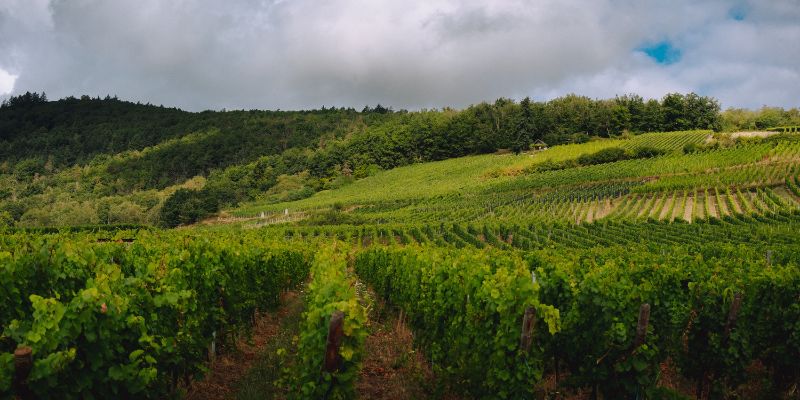Introductory Wine Course
Wine Geography
Geography fundamentally shapes every aspect of wine production, from which grape varieties can ripen successfully to the flavors and structures those grapes develop. Mountains, rivers, lakes, and other geographic features create microclimates that protect vines, moderate temperatures, and influence rainfall patterns in ways that make the difference between exceptional wine and no viable viticulture at all. Understanding how physical landscape interacts with climate helps explain why certain regions produce distinctive wines and why vineyard location matters so profoundly. Geography represents the foundation upon which all winemaking builds, determining what grows where and how those grapes express themselves in the finished wine.
How Geography Shapes Wine: Physical Features and Climate
Mountains influence wine regions in multiple ways, creating rain shadows that limit precipitation on their leeward sides and establishing altitude gradients that offer cooler temperatures and greater diurnal variation as elevation increases. The Andes protect Argentina's Mendoza from excessive rainfall while providing high-altitude sites where intense sunlight and cool nights preserve acidity in ripe grapes. California's Coast Ranges shield inland valleys from marine influence, creating warmer conditions for Cabernet Sauvignon while leaving coastal areas cool enough for Pinot Noir. Rivers and lakes moderate temperature extremes through thermal mass, absorbing heat during the day and releasing it at night to prevent frost damage and extend the growing season. The Mosel River in Germany reflects sunlight onto steep vineyard slopes, aiding ripening in a marginal climate, while Lake Geneva performs similar services for Swiss and French vineyards. Bodies of water also create morning fog that cools vineyards, as seen in California's Russian River Valley where fog delays ripening and maintains acidity. Streams provide drainage, preventing waterlogged soils that would dilute flavors and encourage disease. These geographic features work together to create the specific conditions that allow particular grape varieties to thrive.
The French concept of terroir has been a guiding force in terms of modern wine production; site selection is truly everything.
Site Selection and Viticultural Challenges
Choosing vineyard locations requires understanding how geography creates opportunities and presents challenges. Slope matters enormously, with hillside vineyards offering superior drainage, air circulation that reduces frost and disease pressure, and varied sun exposure depending on aspect. South-facing slopes in the Northern Hemisphere receive maximum sunlight, while north-facing sites stay cooler, allowing winemakers to match variety to exposure. Soil composition, influenced by underlying geology and erosion patterns, affects water retention, nutrient availability, and root penetration. Rain shadows created by mountain ranges produce arid conditions that reduce fungal diseases like mildew and botrytis, though insufficient rainfall requires irrigation in places like eastern Washington and parts of Australia. Conversely, excessive moisture in maritime climates increases disease pressure, demanding careful canopy management and sometimes requiring specific rootstocks resistant to maladies. Geographic features also create wind patterns that can desiccate vines or provide beneficial cooling. Argentina's zonda winds and France's mistral both influence regional viticulture significantly. Understanding these factors allows growers to select appropriate sites, choose suitable varieties, and implement farming practices that work with rather than against natural conditions.

Terroir: The Complete Expression of Place
Terroir encompasses the complete natural environment affecting a vineyard, integrating climate, soil, topology, and geography into a holistic concept that explains why wines from specific sites taste distinctive. The term extends beyond simple location to include every environmental factor: bedrock geology that determines soil parent material, soil depth and structure affecting water and nutrient availability, elevation influencing temperature and sun exposure, proximity to water bodies moderating climate, and even native yeast populations contributing to fermentation character. Burgundy exemplifies terroir's importance, where vineyards separated by mere meters produce notably different wines due to subtle variations in soil composition and drainage. The concept helps explain why Chablis Chardonnay tastes markedly different from Meursault despite both being Burgundian Chardonnay, or why Barolo and Barbaresco, neighboring Nebbiolo regions, express distinct personalities. Terroir represents the intersection of natural science and sensory experience, demonstrating how measureable environmental factors translate into perceivable differences in aroma, flavor, and structure. Understanding terroir deepens appreciation for wine as an agricultural product intimately connected to the land that produces it, shaped by forces both visible and subtle.
Wine geography reveals how physical landscape determines where grapes grow successfully and how they express themselves. Mountains, rivers, and other features create the climatic conditions and site characteristics that define wine regions, while terroir captures the complete environmental picture that makes each vineyard unique. Recognizing geography's influence helps you understand why certain grapes dominate particular regions and why location matters as much as winemaking skill in producing distinctive, quality wines.